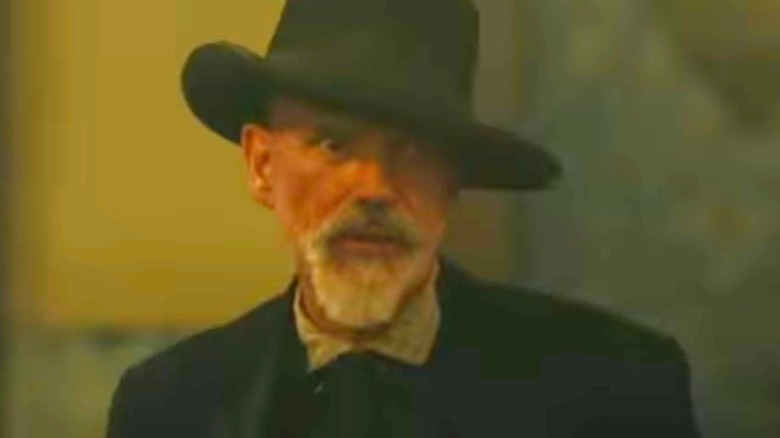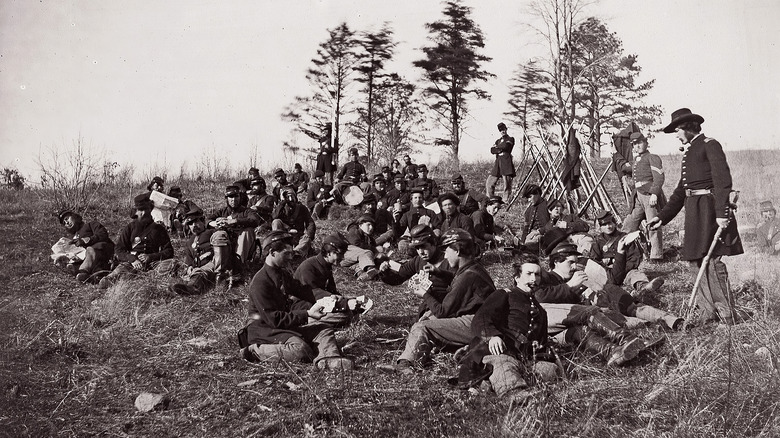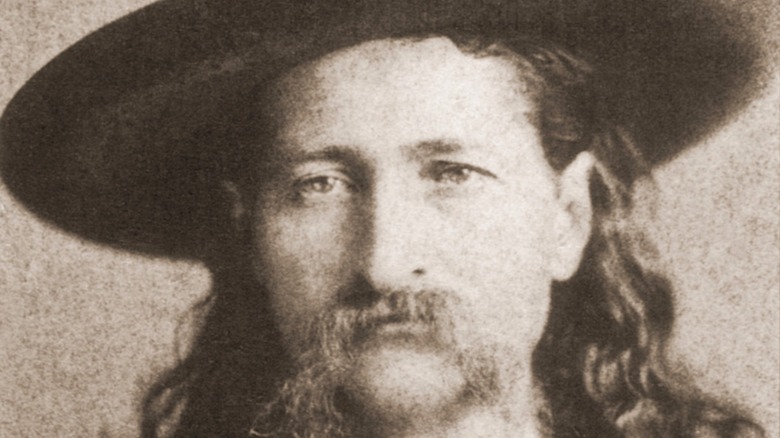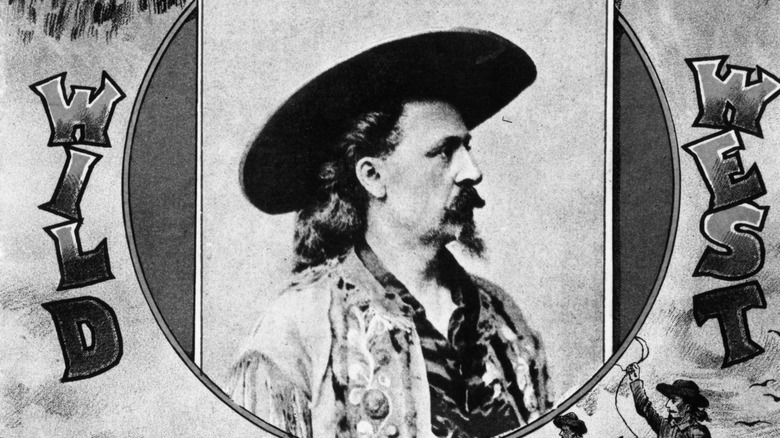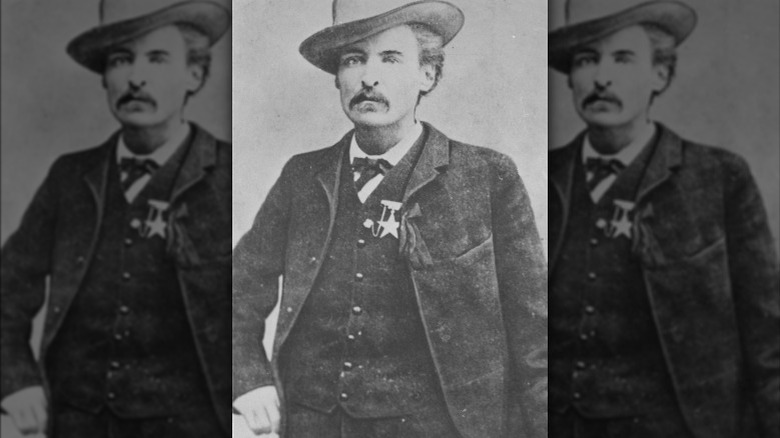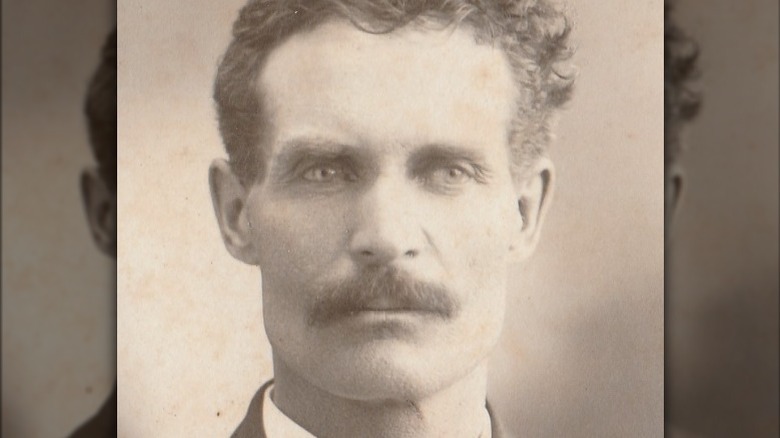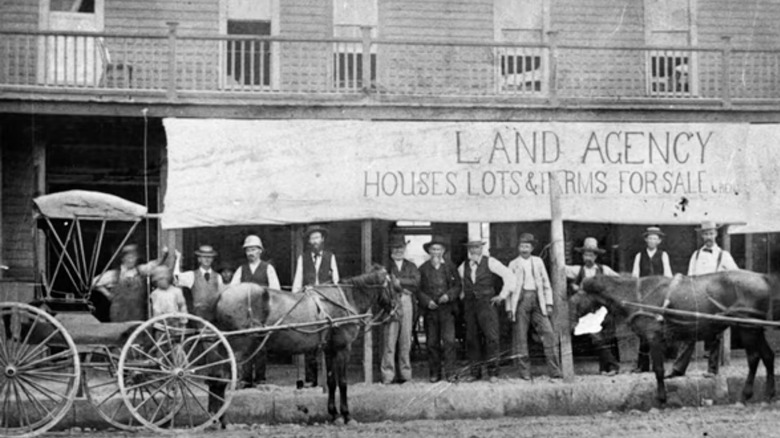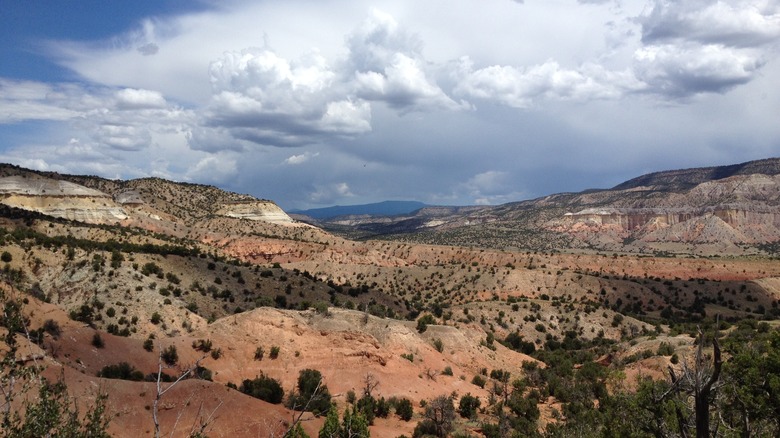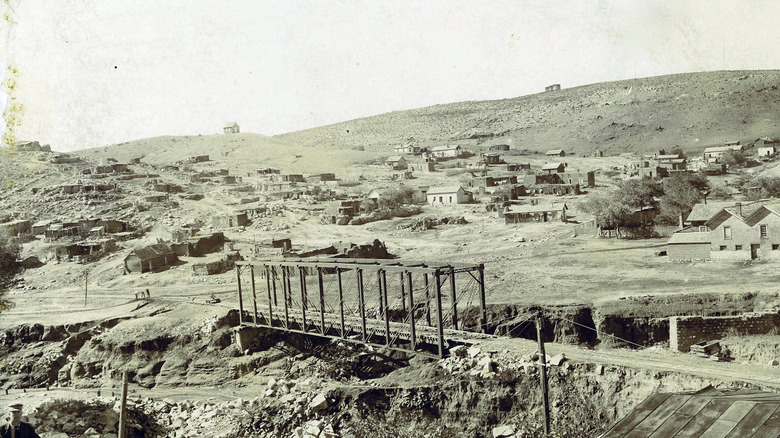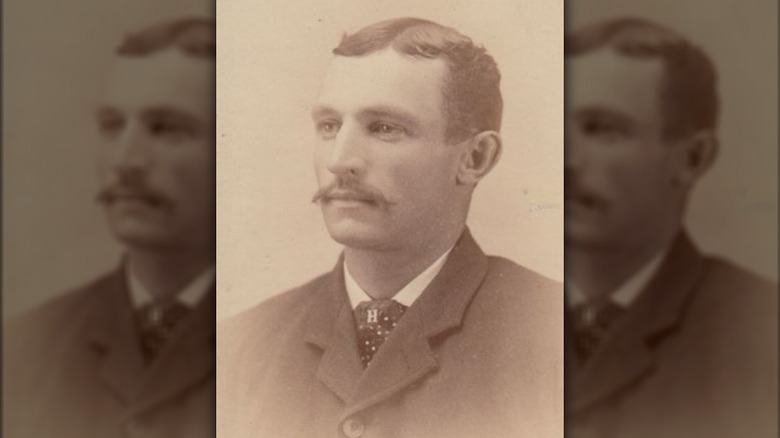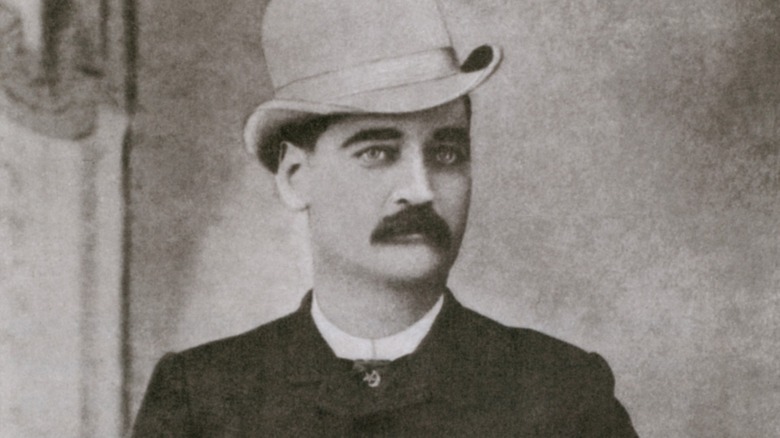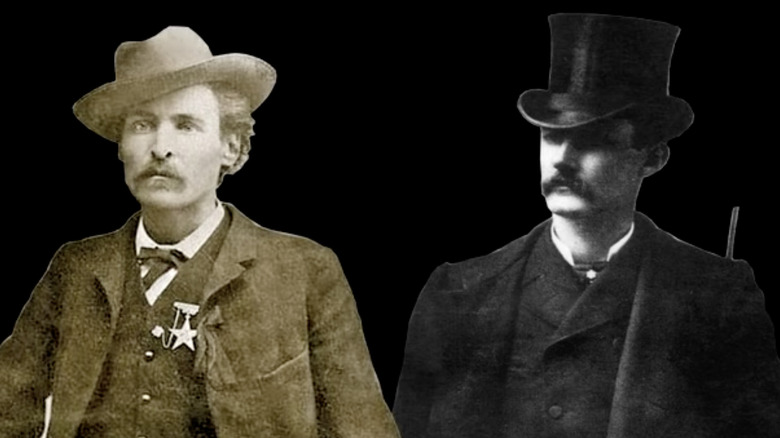The Untold Truth Of Marshall Jim Courtright
Taylor Sheridan's "Yellowstone" has become a phenomenon over the past four seasons. A whopping 14.7 million viewers tuned in for the season four opener, according to Business Insider. These numbers make it the most impressive season premiere of a cable program since "The Walking Dead's" season debut in 2017.
It's little wonder that "Yellowstone" has spawned two much-anticipated spinoffs, "1883" and "6666." "1883" is a prequel to "Yellowstone" and provides the origin story for the Dutton family who settled in the West in the late 19th century. As reported by Country Living, Paramount+ has also announced "6666" is in the works, and it will feature the historic "6666" Ranch where one of "Yellowstone's" most beloved characters, Jimmy Hurdstrom, recently took up residence.
As for "1883," it boasts an incredible cast, including Faith Hill, Tim McGraw, and Sam Elliott (via Taste of Country). The series has also created a buzz by featuring guest stars like Tom Hanks as General George Meade and Billy Bob Thornton as famed Texas Marshal Jim Courtright, per Deadline. By far, the best line from the new series goes to Thornton as Courtright, who proclaims, "There's only one killer in Fort Worth, and that's me" (via Paramount Plus). Here's what you need to know about this Lone Star state lawman and the character he inspired in "1883."
Jim Courtright allegedly fought in the Civil War
In the "Man Who Shot Liberty Valance," Carleton Young delivers an iconic line about the American West. When presented with the dilemma of whether to correct a fictional legend regarding a local hero, he sagely declares, "This is the West, Sir. When the legend becomes fact, print the legend" (via Movie Clips).
This attitude held more than a glimmer of truth when it came to the mythology surrounding frontier figures, including men like Timothy Isaiah Courtright (a.k.a. Jim Courtright). So, it's only fitting that we begin with the parts of his life that look the most like fiction. The Texas State Historical Association (TSHA) reports that at 17 years old, Jim Courtright enlisted in the Union Army during the Civil War with the Seventh Iowa Infantry. According to "Jim Courtright of Fort Worth: His Life and Legend" by Robert K. DeArment, Courtright's early biographer Father Stanley reported his age as 16 and his role as a drummer boy.
At Missouri's Battle of Belmont, Stanley claims Courtright abandoned the drums and foraged a rifle, quickly demonstrating his deadly accuracy. His daring actions caught the attention of Commander John Alexander Logan of the 31st Illinois, who had Courtright transferred to his staff. But later historians have found scant evidence to support this story. These failed attempts to corroborate his exploits with the Union Army have left many scratching their heads about his early life.
He claimed association with Wild Bill Hickok
The next episode of Jim Courtright's life follows fast on the heels of his Civil War service and remains equally undocumented, per Robert K. DeArment in "Jim Courtright of Fort Worth: His Life and Legend." After the Civil War ended, Jim Courtright supposedly stayed in the U.S. Army, serving as a scout alongside Wild Bill Hickok. But historians have faced a dearth of historical evidence to support this claim.
Joseph G. Rosa, noted Hickok expert, has never uncovered a connection between Hickok and Courtright despite decades of tireless research. Nevertheless, Courtright seems to have promoted a reputation as an Indian scout alongside Hickok, per Texas Escapes. He allegedly wore his hair long, a characteristic common among scouts like Hickok and carried a pair of six-shooters with the butts forward. The most famed photos of Courtright depict him with short hair but immortalized for eternity on his tombstone you'll find the nickname, "Jim Longhaired Courtright" (via Waymarking).
According to DeArment's study of Courtright, the long haired legend comes from biographic details spun by Father Stanley Crocchiola and Eugene Cunningham. So does the intermingling of Courtright's life with that of Hickok. In turn, these authors first learned of such colorful (though unverified) stories while exploring oral traditions about the gunslinger that we can presume Courtright started cultivating during his lifetime. Apparently, Fort Worth's future city marshal had no qualms about showboating.
Jim Courtright's wife was a sharpshooter
Another colorful story associated with Jim Courtright is his marriage to Sarah Elizabeth Weeks in 1870, per the Texas State Historical Association (TSHA). He allegedly taught her to be a sharpshooter, and the couple toured with Buffalo Bill's "Wild West" show with Wild Bill Hickok (via Shooting Times). (Sarah used the stage name "Betty.")
But determining a chronology for when Courtright and his wife performed with Buffalo Bill has proven tricky. Early biographers like Father Stanley Crocchiola claimed the duo performed with Buffalo Bill out west in the early 1870s, per Richard F. Selcer's history "Hell's Half Acre: The Life and Legend of a Red-Light District." But historical records show Buffalo Bill remained on the East Coast until the late 1870s.
The Buffalo Bill Museum and Grave in Golden, Colorado, has compiled a booklet of where the fabled performer toured. It confirms performances in the late 1870s, including one in Virginia City, Nevada, in 1877. There, Courtright and his wife allegedly had a falling out with the Western legend after an accidental shooting left Courtright in the hospital. (Interestingly, this story bears a striking resemblance to the well-documented account of Captain Jack Crawford, accidentally shot in Virginia City during a performance with Buffalo Bill in June 1877, per Center of the West.) With a little massaging of the dates, some historians believe that Courtright and his wife performed with Buffalo Bill's fabled "Wild West" later. But there are problems with this assumption, too.
Delineating fact from fiction in Texas
Getting past the murkiest parts of Jim Courtright's life brings us to the verified tales from Fort Worth. These episodes ensured his reputation as a legendary frontier marshal, per the Legends of America. And they're backed by historical evidence. Harmonizing them with the uncorroborated narratives proves difficult, though.
The Courtrights arrived in Fort Worth, Texas, around 1873 to homestead, according to the Texas State Historical Association (TSHA). But by 1876, they moved into town. There, Courtright pursued a career as a lawman, throwing in his name for city marshal. He won the election by three votes in 1876. As the first elected marshal, he had his work cut out for him policing Hell's Half Acre, the most notorious red-light district in Texas, according to the TSHA. But he confronted the challenge head-on.
On the topic of fact versus fiction, his election date blows the Buffalo Bill "Wild West" claims out of the water. After all, it's hard to imagine Courtright, city marshal of Fort Worth, leaving for Virginia City, Nevada, to perform with Buffalo Bill in 1877. Richard F. Selcer notes in "Hell's Half Acre: The Life and Legend of a Red-Light District" that the Courtrights likely didn't tour with the "Wild West" in the early 1880s, either. By then, Courtright faced murder charges in New Mexico, per the TSHA. Under these circumstances, occupying the public eye with Buffalo Bill would seem highly inadvisable.
Jim Courtright cleaned up the streets of Fort Worth
Jim Courtright enjoyed incredible success as city marshal of Fort Worth and got reelected two more times, per the Texas State Historical Association (TSHA). During his tenure, he boasted a 50% reduction in the murder rate, Newsweek reports. Taming the city sometimes involved jailing as many as 30 people a night, per the TSHA.
He also fulfilled many other roles in the city. These included jailer, killer-for-hire, deputy sheriff, racketeer, and private detective, as reported by Outsider. Some also claim he served as a Deputy U.S. Marshal as his tombstone epitaph suggests (via Waymarking). But Richard F. Selcer sets the record straight in "Hell's Half Acre: The Life and Legend of a Red-Light District." He notes that "contrary to popular legend, [Courtright] was never a U.S. Marshal, although he did serve briefly as a deputy marshal during the KATY Railroad Strike of 1885."
During his stint as marshal in Fort Worth, Courtright gained a reputation for gunning down many men. His willingness to use whatever force necessary to bring Hell's Half Acre under control earned him both the fear and respect of the local citizenry. But what we call psychopathy today, looked more like courage in the 19th century. As the Fort Worth Daily Democrat put it on March 30, 1879, "No braver man than Jim Courtright exists. He would arrest a circular saw if necessary" (via Robert DeArment's "Jim Courtright of Fort Worth: His Life and Legend.")
Law and order came at a steep price
Like Liam Neeson dealing with human traffickers, Jim Courtright had "a very particular set of skills" when it came to gunslingers and outlaws (via Rotten Tomatoes). Policing Fort Worth, Texas, required a fast draw and fearless character, according to "Jim Courtright of Fort Worth: His Life and Legend" by Robert K. DeArment. He had talent in both areas, killing without hesitation. But Marshal Courtright's ruthlessly imposed order in Hell's Half Acre between 1876 and 1879 came at a price for local business owners, as reported by Newsweek. He charged extortion money for keeping things on an even keel and business running as usual, and he found a clever way to do it.
In 1878, the secretive Texas Detective Bureau announced its opening, per DeArment. An advertisement dated October 6, 1878, in Fort Worth's Democrat listed the organization's mission as "discover[ing] swindlers and criminals and bring[ing] them to justice, wherever they may be concealed." The ad listed no address or owners' names. However, many historians agree that Courtright spearheaded the group. The organization's clandestine nature stemmed from the fact he couldn't run the business and work as a city marshal simultaneously. But the Texas Detective Bureau permitted him to discreetly collect protection money.
No stranger to controversy, Courtright had two criminal indictments against him while waging his third election campaign, according to DeArment. Remarkably, he ran unopposed without even putting his name on the ballot and won.
He spent a stint in New Mexico
Marshal Jim Courtright's luck couldn't hold out forever, though. In 1879, he lost his fourth reelection in Fort Worth, according to the Texas State Historical Association (TSHA). This development didn't ultimately deter him from the law enforcement/racketeering industry, though. He relocated to American Valley, New Mexico, where he enjoyed a brief stint in the ranching "security" industry (via Robert K. DeArment's "Jim Courtright of Fort Worth: His Life and Legend").
What happened in New Mexico remains somewhat obscure. But he worked for John A. Logan, his supposed former Civil War acquaintance, according to the Shooting Times. Jim McIntyre, who also worked for Logan, elaborated that the Civil War veteran hired Courtright and him for $10 a day to survey New Mexico's Western Slope. Tasks also involved more dangerous pursuits, like flushing out cattle rustlers. Logan purchased the land with the backing of an "Eastern syndicate." But he worried about the infamous cattle rustler conflicts for which New Mexico was gaining a national reputation. (Think, Lincoln County War.)
DeArment argues that the $10 a day the men supposedly received had to come from local ranchers rather than Logan and the other investors in the property. He also hypothesizes that Logan's partners in the venture, John P. Casey and W.C. Moore, "had larger and darker plans for the imported gunmen than simply putting heat on cattle thieves."
The American Valley Murders and returning to Fort Worth
The crew Jim Courtright and Jim McIntyre rode with became overzealous in flushing out rustlers and squatters, and soon, five men faced murder charges for the cold-blooded executions of two homesteaders, Alexis Grossetete and Robert Elsinger (via Robert K. DeArment's "Jim Courtright of Fort Worth: His Life and Legend"). Grossetete and Elsinger both had legitimate land claims, and their deaths "made the American Valley infamous." At first, only John P. Casey and W.C. Moore stood trial with the other men, including Courtright, dispersing across the West as fugitives.
Courtright made his way back to Fort Worth, per the Texas State Historical Association (TSHA). Eventually, Texas Rangers showed up to arrest him, but more than 2,000 Fort Worth citizens armed to the teeth came to Courtright's aid. Despite the show of support, Courtright got apprehended but later made a run for it. Eventually, Courtright turned himself in, facing justice in New Mexico but insufficient evidence led to his release.
Courtright returned to Fort Worth and opened the T.I.C. (Timothy Isaiah Courtright) Detective Agency in 1884, according to Robert K. DeArment in "Jim Courtright of Fort Worth: His Life and Legend." An advertisement in the Dallas Morning News (via Hometown by Handlebar) stated the agency handled everything from missing person cases to criminal actions. He used a logo like the Pinkerton Agency's all-seeing eye to promote T.I.C. As with outlaws, Courtright showed no fear going toe-to-toe with the most prominent private investigators.
Trouble at the White Elephant Saloon
Jim Courtright soon returned to his protection racket, navigating a fine line between law enforcement and outlawry (via the Legacy of the West). But when he approached the White Elephant Saloon's co-owner Luke Short, he encountered pushback, per the Legends of America.
In April 1907, Bat Masterson published an account of the altercation between Short and Courtright in "Human Life Magazine," recalling that "it appears that this fellow Courtright ... had asked Short to install him as a special officer in the White Elephant." Short refused, telling Courtright that locals feared him and his presence would scare away business. (Taylor Sheridan gives us a good taste of this "fear factor" during Billy Bob Thornton's brief appearance as Courtright in "1883" although he takes liberties with other details of the marshal's life, as reported by Town and Country.)
Short appeared understandably confident in his ability to handle the saloon's gunslinging needs. After all, he previously owned the Long Branch in Dodge City and rubbed elbows with Bat Masterson and Wyatt Earp (via the Legends of America). But Courtright wanted a cut of the revenues from "the largest and most magnificent establishment in the state," per Jack De Mattos' and Chuck Parsons' "The Notorious Luke Short: Sporting Man of the Wild West." This meant their paths would cross again. And soon.
Jim Courtright versus Luke Short
On February 8, 1887, at 8 pm, Jim Courtright again confronted Luke Short, attempting to strong-arm him into his "protection services," per Texas Escapes. Rumors already circulated that Courtright had murdered a handful of business owners who refused his protection, as reported by Shooting Times. As the argument heated up, Courtright and Short took it outside.
After walking a short distance, the men faced off in front of Ella Blackwell's Shooting Gallery. Courtright had a reputation for an unmatched draw and deadly accuracy, but he may have underestimated Short. According to Texas Escapes, Courtright exclaimed, "Don't you pull a gun on me," as he went for his pistol. But it got caught on his watch chain, providing an extra second for Short to act.
Short shot first, disabling Courtright's right hand by tearing off his thumb. Courtright reflexively attempted the "border shift" to get his firearm into his left hand, but Short outplayed him once more. He pumped lead into Courtright's body, dropping the former marshal to the ground. As the legendary Fort Worth lawman struggled to breathe, he exclaimed, "Ful, they've got me." He directed this last statement to John Fulford, a city police officer who came at the percussive sound of the shots.
The aftermath of the Courtright-Short shootout
Maybe Jim Courtright had trouble winning reelection in his fourth bid for city marshal of Fort Worth, but few doubted his local popularity, per the Texas State Historical Association (TSHA). Not only had the town turned out armed to save him from the Texas Rangers, but his funeral procession took up six blocks, the "largest the city had seen."
The Courtright-Short duel brought renewed attention to the lawlessness of Hell's Half Acre, sparking calls for reform, as reported by the TSHA. Ironically, the gunfight between Courtright and Luke Short didn't even take place in Hell's Half Acre proper. Nonetheless, it focused public attention on cleaning up Fort Worth's infamous neighborhoods. Although Courtright enjoyed a mixed reputation as a lawman who operated on both sides of right and wrong, he did earn a reputation for bringing peace to Fort Worth.
Western historians still rank him as one of the fastest and most accurate guns of the West, as reported by Robert K. DeArment in "Jim Courtright of Fort Worth: His Life and Legend." DeArment quotes one of Courtright's first biographers, Father Stanley Crocchiola, writing, "The frontier has yet to produce a man as fast on the draw as Jim Courtright ... [He] was as fast as the twinkle of an eye when it came to drawing his six-shooters." One thing's for sure. Seeing Billy Bob Thornton bring the Lonestar lawman back to life has been a treat for "Yellowstone" fans and Western history buffs alike.
